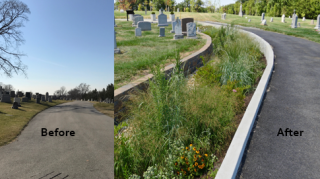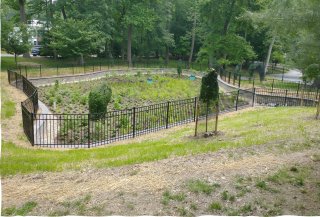Off-site Stormwater Management in Washington, District of Columbia
Background
Off-site stormwater management gives property owners compliance flexibility when planning and designing retention-based stormwater facilities to meet the District of Columbia’s (the District’s) stormwater management requirements. This flexibility promotes green infrastructure construction throughout the District and emphasizes water quality and additional benefits in high priority areas of the District served by the municipal separate storm sewer system (MS4).
At a Glance
Location: Washington, DC
Mechanisms: stormwater retention credits
Geographic scope: citywide
Visit: DC Stormwater Retention Credit Trading Program
Beginning with the adoption of the Department of Energy and Environment’s (DOEE’s) Stormwater Rule in 2013, development projects in the MS4 and Combined Sewer System (CSS) over 5,000 square feet trigger the District’s stormwater management requirements. These require retention of either the 1.2-inch storm for land-disturbing activities or the 0.8-inch storm for building renovations. Developers can comply off-site, either partially or entirely, by purchasing Stormwater Retention Credits (SRCs) from private sellers. The combination of greater compliance flexibility and increased environmental benefits associated with off-site retention and SRC trading was essential to passing the District’s new stormwater management requirements.
Program Details
The SRC Trading Program allows regulated development projects to meet all or part of their stormwater retention requirement off site using SRCs. Depending on location, developers may need to install a minimum amount of retention on site, although some areas of the District have no on-site requirement. These rules are constructed to promote the installation of more green infrastructure in the MS4 area, where stormwater drains directly into the District’s rivers and streams with little to no treatment.
The District’s strategies for managing stormwater runoff in the MS4 and CSS areas provide a foundation for off-site retention and SRC trading. In the MS4, retention-based green infrastructure is the primary way to treat stormwater runoff and protect local waterbodies. In the CSS, the District’s water and sewer authority is installing large underground storage tunnels as well as green infrastructure in certain areas to reduce combined sewer overflows (CSOs) by over 90 percent and improve water quality.
What Is an SRC?
An SRC is a tradable unit, certified by DOEE, representing one gallon of retention capacity for one year installed voluntarily or in excess of a retention requirement of a regulated site.
A high-impact SRC is one generated by new green infrastructure voluntarily built in the MS4 area. High-impact SRCs provide greater water quality benefits than SRCs generated by oversizing required green infrastructure and SRCs from green infrastructure installed in the CSS area.
How Are SRCs Generated?
SRCs can be generated by any entity—an individual, private organization, or government agency—that either:
- Voluntarily installs retention-based stormwater control measures that retain stormwater or
- Installs retention-based stormwater control measures that retain stormwater beyond a project’s regulatory requirement (i.e., oversizing required green infrastructure).

The property owner must submit an SRC certification application within three years of the project’s construction completion and within six months of a DOEE inspection. DOEE must approve this application before the property owner may sell or use those SRCs. DOEE will approve up to three years’ worth of SRCs at one time. For example, a site with 1,000 gallons of SRC eligibility can certify 3,000 SRCs every three years.
The property owner must commit to regular maintenance of their stormwater control measures per DOEE’s Stormwater Management Guidebook through the certification period. Stormwater control measures must pass a maintenance inspection before each new certification period. Failure to maintain a stormwater control measure that is generating SRCs may result in retirement of those SRCs. Note that the Guidebook refers to retention-based stormwater control measures as best management practices (BMPs).
How Are SRCs Used?
Each year, property owners that choose to manage stormwater off site must purchase SRCs from private sellers and apply them to their sites. Buyers and sellers privately negotiate the price and any other terms, which may include a multi-year purchase agreement to ensure steady revenue to the SRC seller. Buyers may also purchase multiple years’ worth of SRCs to comply for many years at once. Property owners can also use SRCs generated on other sites that they own.
The sewer system into which a site discharges determines the types of SRCs that property owners may use. For example, projects in the MS4 area may only use SRCs generated in the MS4 area, not the CSS area. High-impact SRCs may be used to meet off-site requirements for any site in the District.
Creating an SRC Trading Market

When establishing the program, DOEE balanced the need to create an initial supply of SRCs in a first-of-its-kind market with the need to offer flexible compliance options and compelling incentives to restore water quality. During the early phases of the SRC Trading Program, DOEE allowed SRC generation above a project’s regulatory requirement rather than only allowing new, voluntary green infrastructure to generate SRCs. This policy established a reliable supply of SRCs: as of 2022, there have always been enough SRCs for sale to meet annual demand.
Because the SRC market has an ample supply of SRCs, DOEE plans to establish new rules that prioritize the use of high-impact SRCs. This prioritization will help ensure a long-term, stable supply of SRCs that maximize water quality benefits to local waterbodies and accelerate the District’s restoration efforts.
Tracking Compliance
All stormwater management projects are tracked in DOEE’s online Surface and Groundwater System (SGS) database, which also contains an SRC Registry that includes SRCs for sale, past SRC sale prices, and contact information for SRC sellers.
DOEE also uses the SGS to manage all administrative processes related to the stormwater management regulations, including plan review, inspections, and SRC certification.
As of 2022, approximately 14 percent of regulated projects have chosen to use off-site retention to meet all or a portion of their stormwater requirements. Cumulative off-site retention volume has steadily increased since the program was adopted in July 2013, from 11,000 gallons in 2014 to over 560,000 in 2022. Overall SRC demand has also consistently grown, with many different types of property owners and SRC generators participating in the program.
SRC Price Lock Program
To support SRC aggregators—businesses that install new, voluntary green infrastructure in the MS4 (i.e., high-impact SRCs)—DOEE created the SRC Price Lock Program. SRC Price Lock participants have the option to sell SRCs to buyers on the open market or to DOEE at guaranteed prices. As part of this purchase guarantee, DOEE reserves funds in advance to buy 12 years of SRCs generated from an SRC Price Lock project. The option to sell to DOEE and the reservation of funds provide SRC aggregators with certainty about the revenue from an SRC-generating project.
The SRC Price Lock Program also includes a subsidy for SRCs sold on the market. Under this option, DOEE will pay a portion of the SRC sale price on behalf of the buyer. This helps SRC Price Lock participants sell high-impact SRCs at competitive prices on the market. By subsidizing market sales, DOEE spends less money than it would have by purchasing the SRCs at the guaranteed purchase price. Subsidized SRC sales on the market also allow DOEE to re-allocate the unspent portion of reserved funds to support new SRC Price Lock projects. This approach helps DOEE maximize the utility of limited SRC Price Lock Program funds and encourage more new, voluntary SRC-generating projects in the MS4.
Lessons Learned
- Design programs with a growth mindset
- Prepare systems and standard business processes early. Build them to be adaptively managed as they are implemented.
- Build systems to collect data for performance indicators, regularly track program performance, and establish regular performance review periods to improve process efficiency and outcomes.
- Develop tools for multiple types of users
- A robust, intuitive online database is critical to ensure members of the public can use the system easily, with minimal staff intervention, from a project’s permitting phase through the long-term compliance period.
- The database should also be able to meet the needs of many teams within the regulatory agency (e.g., plan review, inspection, credit program staff).
- Benefits
- Installing green infrastructure helps to capture and filter runoff; prevent pollution and erosion of small streams by stormwater; improve air quality, wildlife habitat, and climate resiliency; and beautify local communities through increased green space.
- Off-site compliance flexibility incentivizes property owners to install green infrastructure throughout the city, including in underserved areas, instead of concentrating it in highly developing areas. Without the SRC Trading Program, areas with lower redevelopment rates (which are often underserved) would have fewer opportunities for green infrastructure installation.
- Driving installation of new, voluntary stormwater control measures increases first-flush capture and improves total retention on an annual basis across the District. Voluntary stormwater control measures manage new areas that would otherwise not receive treatment, whereas an oversized stormwater control measure on a regulated project only captures additional volume with less concentrated pollutants, during large, less frequent storms.
- The SRC Price Lock Program and SRC Aggregator Grant Program, which incentivize the installation of voluntary, cost-effective stormwater control measures in the MS4 by SRC-generating businesses, help support a long-term stable supply of SRCs that do the most to protect District rivers and streams.
